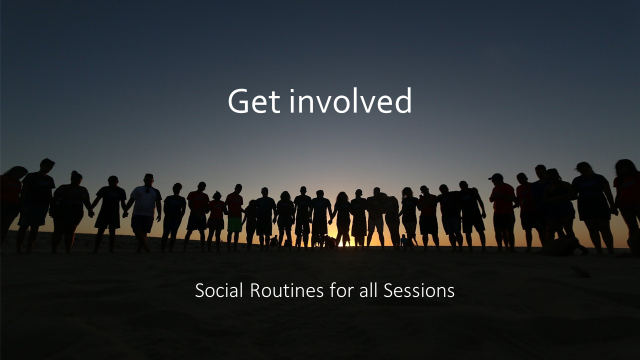Getting closer and get involved: How to support social closeness and active participation in the virtual classroom
Measures to promote social closeness and active participation for all sessions

Social routines fo all sessions
There are very many different ways to encourage closeness and participation in online teaching.
The social routines presented here should therefore by no means all be implemented in a course, but serve as a pool of ideas from which you should select specifically what suits you personally.
Therefore, rather pick 2-3 favorite routines and schedule a little time for them in each session. Every now and then, surprise yourself and your students with something new.
How are you today? Drop-In Time

As a lecturer, it is recommended to be there 15 minutes before the start (this should be announced in advance) to have time for a short informal exchange with the students. In smaller groups you can also greet arriving participants personally (ideally even by name, the names are usually given in the webconference tool). If students don't ask questions on their own, you can include conversation-stimulating stimuli - such as asking the week before for items to be brought in or backgrounds to be posted that reveal something about the student's personality (their favorite book or movie, an item related to a hobby, etc.), or you can post a small garlic knot that you'd like to share with the students. ), or you can set a small brainteaser whose solution is discussed (cf. Baumann 2009: pp. 9-10)[1], play picture, music, or quote stimuli and have them express thoughts about them, give one or more "fun facts," etc. The end of the drop-in time should be clearly signaled (e.g., fade in a slide, play a gong) and the course should start on time.
Ice-Breaker: Warming up socially

Conceptboard:
Digital pin board which can also be used for mindmaps; ideal for collaborative work; account necessary, free of charge
Onlinequestions:
Digital pin board which can be used to collect questions, for a written brainstorming or for obtaining feedback; no account necessary, free of charge
- Have one (not multiple) ice-breaker question answered in chat, e.g., Where are you right now? What do you see when you look out the window? How has your day been so far? For later events, when some trust has already been established: what has been a highlight for you this week? What are you grateful for right now? What made you smile this week? What are you most looking forward to right now?
- Photo challenge: Everyone sends in a picture of their workplace/favorite food/hobby/view from their own window and the others guess who owns which picture (for medium-sized groups this can be done over several weeks, each week some participants present their photo). This can be implemented, for example, with a collaborative pinboard such as Conceptboard (share board: "Everyone with link has access to edit" - then students can upload photos to the pinboard and comment on others' photos).
- Can also be used to "warm up" content, e.g., to ask about expectations for the course: What would you like to see in today's course? What question do you have for today? Students can answer the question either in the chat (names are visible) or anonymously via a bulletin board such as Onlinequestions.
Some kind of Hollywood for everyone: Using the camera

- Living statistics: indicate your point of view by proximity/distance to the camera (sample questions: How close are you to Giessen? When did you start to get involved with topic XY?).
- Voting by thumbs: have yes/no questions answered by camera - thumbs on camera means no.
- Voting via facial expressions or gestures: ask students to answer questions about mood based on facial expressions, gestures and body posture; initial content-related questions for the thematic introduction are also conceivable.
- Design background: Ask students to choose a background image related to the topic of the seminar, either use the backgrounds for a round of introductions or make them a topic in the discussion.
- Use analogies to film: Students' attitudes toward the camera can possibly be positively promoted through analogies to film. For example, you can ask the students to design the real background scenically in such a way that it fits the topic or to choose their own outfit in a topic-specific way and discuss these scenes and outfits with reference to the relevant content in the plenary; alternatively, you can have a film poster or trailer created for a topic or create it yourself to arouse curiosity about a topic; you can include short films instead of the classic presentations; or ask which aspects are "main and supporting actors" in the context of a particular topic area; etc.
Three, two, one - Action: Interaction Routines

Harvard University: Going Digital - Section 3: Encourage student interactions
Mind the gap! 5 communicative activities for the socially distanced classroom
Flinga:
Digital pin board, also useful for creating simple mindmaps; can be used collaboratively; account necessary for teacher (not for students), free of charge
Onlinequestions:
Digital pin board which can be used to collect questions, for a written brainstorming or for obtaining feedback; no account necessary, free of charge
Sli.do:
Tool for polls and votings, integrated in Webex
Tweedback:
Plattform for obtaining anonymous real-time feedback (Chat-Wall, Panic-Button, Quiz)
- Conduct a partner interview on a specific question, have results noted (in chat, on an Etherpad, via mindmap, on virtual cards with Onlinequestions or Flinga) and refer to them afterwards.
- Start a survey (e.g. via survey tool) and comment and discuss the results.
- Collect topics and questions of the students on a board and prioritize them via star rating (e.g. via Onlinequestions). The most urgent questions are dealt with directly afterwards.
- Conduct (anonymous) written brainstorming (via an Etherpad or a digital bulletin board such as Onlinequestions or Conceptboard) - either in advance on prior knowledge ("What do you already know about topic XY?") or after an input ("Which three points have stuck with you?"). Subsequently, incorporate the mentioned and/or also missing points into the course.
- "Panic button": students can anonymously signal by selecting a button if there is a problem (e.g. "too fast", "too quiet", "please give an example", "last slide again" - e.g. via Tweedback.
- Provide a platform where questions can be asked anonymously at any time (e.g. online requests or via an anonymous forum); these questions should then be taken up during the course or dealt with later (the forum is particularly suitable for this).
- At the end of a session, have small groups (via breakout rooms) create five-minute collaborative take-home messages or review questions ("What could be review questions for today's session?"). If a digital bulletin board or Etherpad is used for this, the results can also be shared between groups. This collection is a good way to start the upcoming session.
„Together Everyone Achieves More“: TEAMs in online learning

- Working on a project (Project-Based Learning), e.g., collaboratively creating a digital learning product (video, podcast, tutorial, etc.).
- Working on a problem (problem-based learning, case-based learning).
- Working on a research assignment (inquiry-based learning).
Meet and mingle: Get in touch with other teams

Etherpad:
Editor for synchronous, collaborative text creation; integrated in ILIAS
Conceptboard:
Digital pin board which can also be used for mindmaps; ideal for collaborative work; account necessary, free of charge
Onlinequestions:
Digital pin board which can be used to collect questions, for a written brainstorming or for obtaining feedback; no account necessary, free of charge
- Use of collaborative tools (e.g. Etherpad, online bulletin board or similar), in which all groups as well as the teacher can make entries and view those of the other groups at the same time.
- Set up a "mingle phase"/"get together": for a certain period of time, students are allowed to visit another group and then go back to their group with new information.
- A method in which structured mixing (between core groups and expert groups) is designed is the group puzzle.
- Indirect contacts of the groups can also be established via the teacher, for example by carrying information from one group to the next (e.g. "the other group has also wondered about this, ..."). Communication of new questions that affect everyone can be sent to all groups at once via a "broadcast" message, for example.
- Alternatively, the message can be copied into each chat of the subgroups or channels or entered into the collaborative tools used (e.g. Etherpad or Onlinequestions).
Give me a break

Harvard University: Going Digital - Section 4: Be flexible and creative
For more ideas have a look at the following web site:
https://www.workshop-spiele.de/online-warm-up-finder/
- A nice way to get active during a break is to do some sports together.The Justus Liebig University offers trainers for online breaks. A sports trainer comes into the online-meeting and does exercises with the participants for 5 minutes.
- Drinking coffee together: everyone picks up a cup and holds it up.
- Include playful elements like "Rock - paper - scissors" - each person chooses a partner on the screen and makes a laola when he/she has won);
- search for objects at home (everyone turns off the camera, order: "Search as fast as you can for something round, something blue, something soft, something liquid .... If you are successful, please quickly turn on the camera and show your found items").
- Instead of turning off the camera during a break, instructors and students can place a "placeholder" in front of the camera (attach a smiley face to the chair, present a character, an object, a book, etc.). This creates interest in each other and probably a laugh or two. It also shows when the room slowly fills up with students again, and it gives an opportunity to engage in small talk after the break.
Let’s talk about our learning success: What have we actually learned today?

Conceptboard:
Digital pin board which can also be used for mindmaps; ideal for collaborative work; account necessary, free of charge
Oncoo:
Several tools for synchronous teaching (account necessary, free of charge)
Sli.do:
Tool for polls and votings, integrated in Webex
Onlinequestions:
Digital pin board which can be used to collect questions, for a written brainstorming or for obtaining feedback; no account necessary, free of charge
The following methods can be used here, for example:
- Collaborative creation of a Take Home Message (e.g., on an online bulletin board or as an online card prompt with Oncoo or online queries).
- Flashlight (e.g., as posts sent together at a specific time in chat / "waterfall")
- collaborative creation of a word cloud, mindmap or learning map for the session (e.g. with an online pinboard like Conceptboard or a WordCloud question in Sli.do)
Let’s talk about the learning process: How well were we actually able to learn today - and what could go better next time?

Oncoo:
Several tools for synchronous teaching (account necessary, free of charge)
Conceptboard:
Digital pin board which can also be used for mindmaps; ideal for collaborative work; account necessary, free of charge
It is important that the feedback from the students then also has consequences, e.g. a topic is explained again, a teaching method is modified or a good suggestion is taken up. Feedback can be obtained in the digital space, for example, as follows, and then put up for discussion:
- Anonymous poll: As a poll or vote with the polling tools of the web conferencing systems.
- Mood picture: Show several pictures/photos/postcards etc. and ask participants to put a cross on the picture that best corresponds to their current mood via the commenting tool of Webex (when the screen is released, a bar appears at the top where the "commenting tools" can be activated and released "for all participants"). If applicable, as an addition: whoever wants to can say something either in the chat or verbally about why he/she chose a picture.
- Dialogue corners on digital pin board (e.g. concept board): What helped you learn today? What made your learning difficult today? What suggestions do you have for improvement? What other feedback would you like to give?
- Also conceivable as "5-finger feedback": thumb: this is top; index finger: I would like to point this out; middle finger: this is flop; ring finger: I will take this with me; little finger: this came up short for me.
What experiences did you make? What other ideas do you have?
Have you already tried out some of the tips and ideas? What went well? What didn't work so well?
Are there any other ideas you've tried to get in touch with students in the sessions and to foster communication and collaboration in the learning community?
Share your experiences and ideas with us - use the comment function on this page.